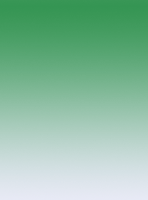| Here
you can find out about the
tours I would like to take
you on. |
|
|
|
|
Picture
puzzle: Can you find
these picture details in
the photos below? Solutions
|
| Nikolaiviertel
- The story of Berlin in
stories and tales |
| |
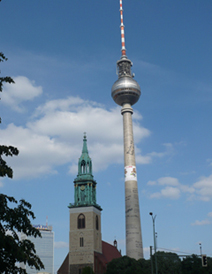
|
Did
you know that Berlin was
“born” on two
islands?
About 200 years ago there
were two sister cities named
Berlin and Cölln.
A lot was going on there
because fishermen, butchers,
textile weavers and other
merchants were offering
their goods on the markets.
New houses are here today,
some were rebuilt to resemble
historic originals.
|
|
St Nicholas Church is
located in Berlin.
It was named after St Nicholas
the patron saint of merchants
and sailors.
After all, Berlin and Cölln
were founded as merchant
cities.
|
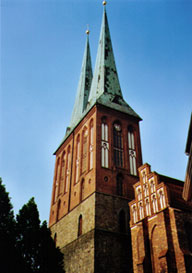 |
| |
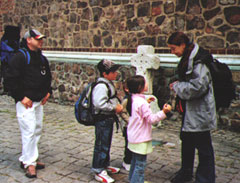 |
Find out about the founding
and development of Berlin,
the age of robber barons
and noblemen.
Listen to the tales of the
haunted castle, the lost
giant and wondrous rescues.
Join me and try turning
St Mary’s Church! |
| Top |
Details |
| Kurfürstendamm
– from bridle path
to shopping avenue |
| |
|
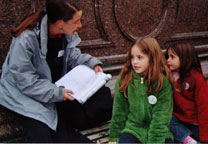 |
Originally
Kurfürstendamm was
a mere passageway outside
the city gates of Berlin,
leading through swampy terrain.
The Elector Joachim II.
would take this path to
ride from Berlin to his
hunting lodge in the Grunewald
forest. This is how the
name "Kurfürstendamm"
was coined – it was
a "Damm" (road)
for the "Kurfürst"
(Elector). |
When, in 1883, Kurfürstendamm
was converted into a splendid
avenue, it became a favourite
place for leisurely Sunday
afternoon strolls. Soon
artists flocked to the newly
established cafés
along the Ku’damm
(that’s the popular
abbreviation of Kurfürstendamm).
Over time, shops, theatres
and cinemas appeared, many
under Jewish ownership.
1912 saw the opening of
the first synagogue in the
outskirts of Berlin.
|
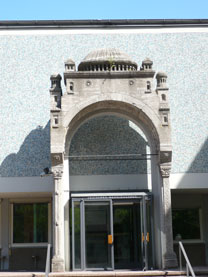 |
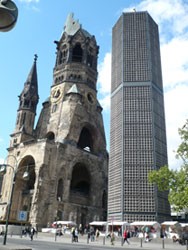 |
Events such
as the November pogrom of
1938, World War II, the
separation and reunification
of Berlin, all worked to
change both the appearance
and the significance of
Kurfürstendamm time
and again.
During the course of this
tour we will also pay a
visit to the Memorial Church
on Breitscheidplatz.
Did you know that this bombed
out church nearly fell victim
to the wreckers? But Berliners
so much loved the “hollow
tooth” that today
still, you can marvel at
the old ruin next to the
new, modern church. |
| Top |
Details |
| A
lot happened at the Brandenburg
Gate |
| |
The
Brandenburg Gate didn’t
always look like it does
today. When it was first
erected in 1734 it was much
smaller. It was one of 14
gates in the wall that surrounded
Berlin at the time.
At these gates, anybody
entering or leaving Berlin
had to submit to a check.
The Brandenburg Gate has
existed in its present form
since 1791, even though
it was destroyed in the
meantime and had to be rebuilt. |
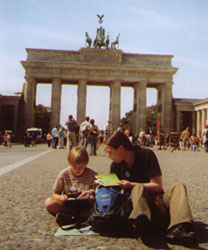 |
 |
In times
of peace as in times of
war, there was always something
going on at the Brandenburg
Gate. Up to the present
day celebrations as well
as demonstrations take place
here. Surely you’ve
seen images of this important
Berlin landmark many times
before.
Have a look in your wallet,
you’ll even find it
on German cent coins! |
As
we happen to be in this
part of Berlin, let’s
walk “on the wall”
and cross from “East”
to “West” with
no more border controls
in sight. Do you know already
what this means? I’m
looking forward to your
questions.
At the river Spree you can
get a little rest and then
you will have to decide
whether giants exist or
not. Finally we will have
a look at the Reichstag
(the German parliament building)
from the outside.
You only realize just how
big it really is, once you
stand right in front of
it! |
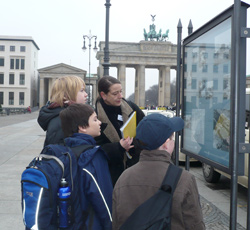 |
| Top |
Details |
| Checkpoint
Charlie |
Just
imagine waking up one morning
and being told, you’re
no longer allowed to cross
the road in front of your
house! Something like that
happened on August 13th
1961 in Berlin.
|
|
“As
of midnight tonight, the
border between West and
East Berlin is closed.”
This is the radio message
informing Berliners they
were no longer allowed into
the other part of the city.
At first, the border was
secured with barbed wire.
Then a tall wall was built
all around West Berlin,
cutting right though the
centre of the city.
That’s how West Berlin
was turned into an “island”
that one couldn’t
easily leave. |
Checkpoint “C”
in Friedrichstrasse is better
known as Checkpoint Charlie.
Neither Berliners nor West
Germans were allowed to
use this checkpoint. It
was reserved for members
of the Allied Forces, soldiers
of the countries that been
victorious in the Second
World War. In October 1961
things got dangerous: there
was a showdown between Soviet
and American tanks at Checkpoint
Charlie! What a relief,
that both sides could settle
the matter peacefully! |
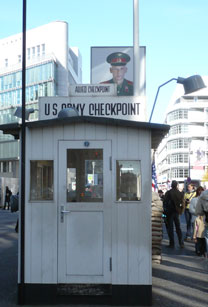 |

|
The Berlin Wall divided
the city between 1961
and 1989. Why it was built,
what it was like to live
with it, things people
thought up to flee to
the West, even though
it meant risking their
lives, why the border
was opened on 9th November
– this and more
I would like to show and
tell you about. |
On this tour
we will also visit the Museum
of Communications, where
some really old robots will
greet you and invite you
to play ball with them.
There are many interesting
things to explore in this
beautiful building and you
will also learn a considerable
bit of the history of the
postal service. |
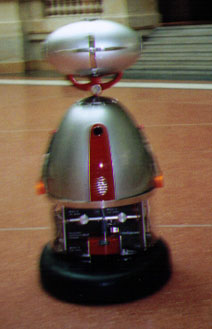 |
| Top |
Details |
|
|



